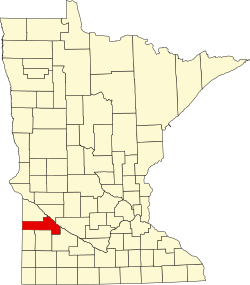Yellow Medicine County | |
|---|---|
 Yellow Medicine County Courthouse in Granite Falls in 2007 | |
 Location within the U.S. state of Minnesota | |
 Minnesota's location within the U.S. | |
| Coordinates: 44°43′N95°52′W / 44.72°N 95.86°W | |
| Country | |
| State | |
| Founded | March 6, 1871 |
| Named after | Yellow Medicine River [1] |
| Seat | Granite Falls |
| Largest city | Granite Falls |
| Area | |
• Total | 763 sq mi (1,980 km2) |
| • Land | 759 sq mi (1,970 km2) |
| • Water | 4.1 sq mi (11 km2) 0.5% |
| Population (2020) | |
• Total | 9,528 |
• Estimate (2023) | 9,467 |
| • Density | 12.6/sq mi (4.9/km2) |
| Time zone | UTC−6 (Central) |
| • Summer (DST) | UTC−5 (CDT) |
| Congressional district | 7th |
| Website | www |
Yellow Medicine County is a county in the southwestern part of the U.S. state of Minnesota. Its eastern border is formed by the Minnesota River. As of the 2020 census, the population was 9,528. [2] Its county seat is Granite Falls. [3]
Contents
- History
- Geography
- Lakes[7]
- Rivers and drainages[7]
- Major highways
- Adjacent counties
- Protected areas[7]
- Demographics
- 2020 Census
- 2000 census
- Communities
- Cities
- Unincorporated communities
- Townships
- Government and politics
- See also
- References
- External links
The Upper Sioux Indian Reservation, related to the historical Yellow Medicine Agency that was here, is entirely within the county. It was established under the Treaty of Traverse des Sioux in 1851, by which the Dakota ceded much territory in the region to the United States.



